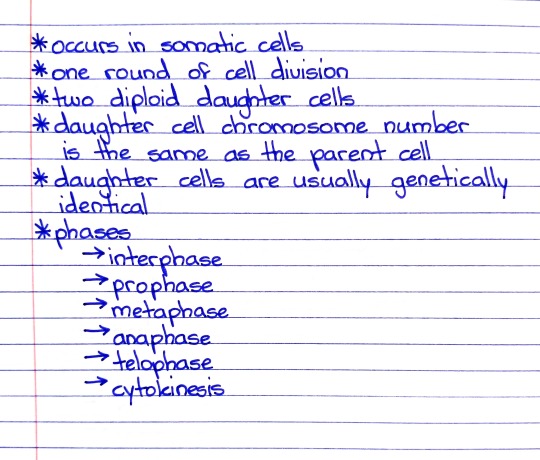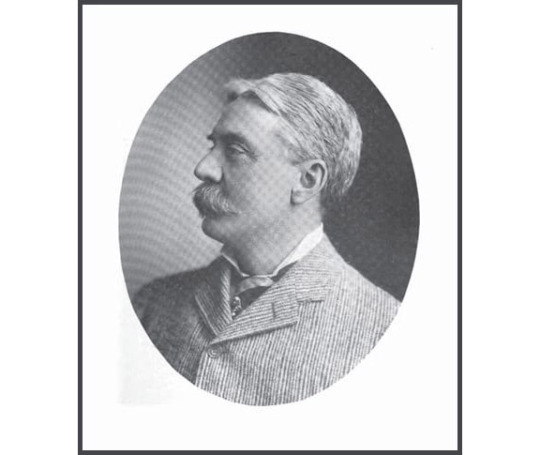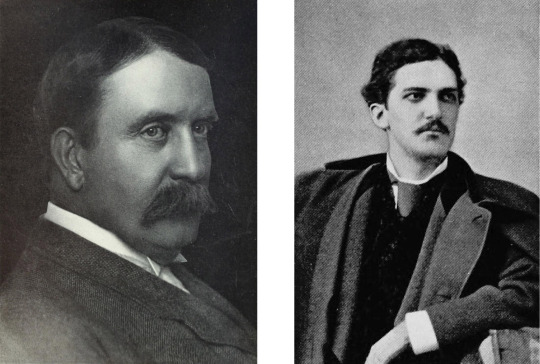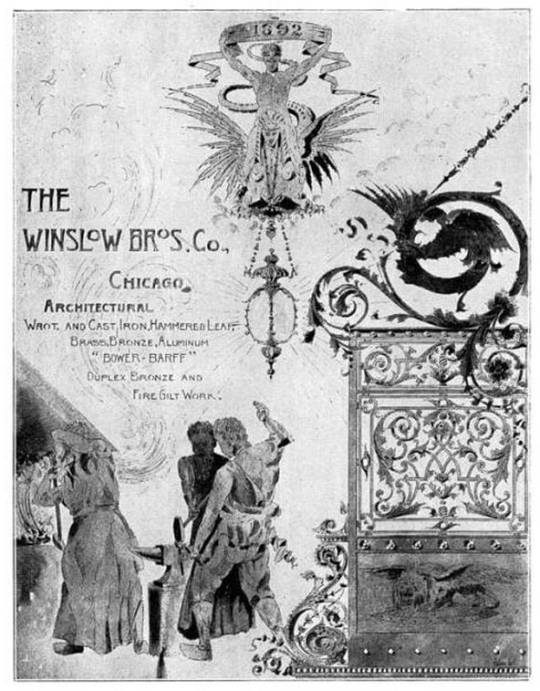#cellular division notes
Photo


#biology#bio#bio notes#biology notes#notes#my notes#studyblr#meiosis#meiosis notes#mitosis notes#mitosis#meiosis vs mitosis#mitosis vs meiosis#cellular reproduction#somatic cells#chromosomes#daughter cells#cell division#cellular division#cell division notes#cellular division notes#cellular reproduction notes
38 notes
·
View notes
Text
"How to Combat Inflammaging, the Aging Side Effect No One Talks About"
Article Date: April 7, 2024.
Article Excerpt:
It may sound like a made-up word, but “inflammaging” is a medical term coined more than 20 years ago to describe the chronic inflammation that happens in our bodies as we get older. “It’s a word that combines ‘aging’ and ‘inflammation’ to describe a low-level inflammatory process,” says Linda Herrmann, Ph.D., a clinical associate professor and aging expert in the Division of Advanced Nursing Practice at Rutgers, the State University of New Jersey. “It’s systemic throughout the body, but occurs in the absence of an acute illness or injury.”
[...]
It turns out that inflammaging is a risk factor for cardiovascular diseases, kidney disease, diabetes, cancer, depression and dementia. “The rise in rates of these conditions are the by-products of a longer life span,” says Nicole Ehrhart, V.M.D.,
[...]
Potential triggers may include genetic susceptibility, obesity, changes in the microbiome and chronic infections.
Another cause seems to be cellular senescence, which is when cells stop replicating, but they don’t die. “Instead, they go into a sort of ‘undead’ state, secreting inflammatory factors and inducing neighbor cells to do the same,” says Ehrhart. [...]
“as we age, our immune system gets less specific to what it’s reacting to. After a while, this cumulative sort of chronic response actually becomes this low-grade chronic inflammation,” says Ehrhart. “It doesn’t’ function like it used to when we were younger.” The result is inflammaging. [...]
How can you prevent inflammaging? [...]
Get moving
Work on your balance
"Eat right"
Manage stress
Spend quality time with others
Get good sleep
[Note: more information in article, take with a bit of skepticism - "a grain of salt"]
#am getting sense that there really isn't much that's known about it to have such vague broad advice n blaming obesity (vague)#text post#o post#magz upload
6 notes
·
View notes
Text
Life-Span Development John Santrock Chapter 3 Notes
-gernminal period- is the period of prenatal development that takes place during the first two weeks after conception. It includes the creation of the fertilized egg, or a zygote; cell division; and the attachment of the zygote to the uterine wall
-differentiation- specialization of cells to perform various tasks
-blastocyst- consists of an inner mass of cells that will eventually develop into the embryo
-trophoblast- an outer layer of cells that later provides nutrition and support for the embryo
-implantation- the attachment of the zygote to the uterine wall
-embyronic period- the period of prenatal development that occurs from two to eight weeks after conception. During this period, the rate of cell differentiation intensifies, support systems for cells form, and organs appear.
-embryo- the blastocyst attaches to the uterine wall and the mass of cells is now called an embryo
-endoderm- the inner layer of cells, which will develop into the digestive and respiratory systems
-mesoderm- the middle layer, which will become the circulatory system, bones, muscles, excretory system, and reproductive system
-ectoderm- the outermost layer, which will become the nervous system and brain, sensory receptors (ear, nose, and eyes, for example), and skin parts (hair and nails, for example)
-the endoderm primarily produces internal body parts, the mesoderm primarily produces parts that surround the internal areas, and the ectoderm primarily produces surface parts
-amnion- a sac (bag or envelope) that contains a clear fluid in which the developing embryo floats
-umbilical cord- contains two arteries and one vein, and connects the baby to the placenta
-placenta- consists of a disk-shaped group of tissues in which small blood vessels from the mother and the offspring intertwine but do not join
-organogenesis- the name give to the process of organ formation during the first two months of prenatal development
-fetal period- lasting about seven months, is the prenatal period between two months after conception and birth in typical pregnancies. Growth and development continue their dramatic course during this time.
-neurons- or nerve cells, which handle information processing at the cellular level in the brain
-Four important phases of the brain's development during the prenatal period involve: (1) the neural tube, (2) neurogenesis, (3) neuronal migration, and (4) neural connectivity.
-As the human embryo develops inside it's mother's womb, the nervous system begins forming as a long, hollow tube located on the embryo's back. This pear-shaped neural tube, which forms at about 18 to 24 days after conception, develops out of the ectoderm. The tube closes at the top and bottom ends at about 27 days after conception.
-A massive proliferation of new immature neurons begins to take place at about the fifth prenatal week and continues throughout the remainder of the prenatal period. The generation of new neurons is called neurogenesis, a process that continues through the remainder of the prenatal period but is largely complete by the end of the fifth month after conception. At the peak of neurogenesis, it is estimated that as many as 200,000 neurons are generated every minute.
-neuronal migration- involves cells moving outward from their point of origin to their appropriate locations and creating the different levels, structures, and regions of the brain
-teratogen- is any agent that can potentially cause a birth defect or negatively alter cognitive and behavioral outcomes.
-The field of study that investigates the causes of birth defects is called teratology.
-The does, genetic susceptibility, and the time of exposure to a particular teratogen influence both the severity of the damage to an embryo or fetus and the type of defect:
-Dose- The dose effect is rather obvious--the greater the dose of an agent, such as drug, the greater the effect.
-Genetic susceptibility- The type or severity of abnormalities caused by a teratogen is linked to the genotype of the pregnant woman and the genotype of the embryo or fetus. For example, how a mother metabolizes a particular drug can influence the degree to which the drug's effects are transmitted to the embryo or fetus. Also, for unknown reasons, male fetuses are far more likely to be affected by teratogens than female fetuses.
-Time of exposure- Exposure to teratogens does more damage when it occurs at some points of development than at others. Damage during the germinal period may even prevent implantation. In general, the embryonic period is more vulnerable than the fetal period.
-embryonic period- when organs are being formed
-a critical period is a fixed time period very early in development during which certain experiences or events can have a long-lasting effect on development.
-psychoactive drugs- act on the nervous system to alter states of consciousness, modify perceptions, and change moods
-fetal alcohol spectrum disorders (FASD)- are a cluster of abnormalities and problems that appear in the offspring of mothers who drink alcohol heavily during pregnancy
-afterbirth- is the third stage, at which time the placenta, umbilical cord, and other membranes are detached and expelled. This final stage is the shortest of the three birth stages, lasting only minutes.
-midwifery- is a profession that provides health care to women during pregnancy, birth, and the postpartum period
-doula- is a Greek word that means "a woman who helps." A doula is a caregiver who provides continuous physical, emotional, and educational support for the mother before, during, and after childbirth
-analgesia- is used to relieve pain. Analgesics include tranquilizers, barbiturates, and narcotics.
-anesthesia- is used in late first-stage labor and during delivery to block sensation in an area of the body or to block consciousness
-oxytocin- is a hormone that promotes uterine contractions; a synthetic form called Pitocin is widely used to decrease the duration of the first stage of labor
-natural childbirth- is the method that aims to reduce the mother's pain by decreasing her fear by providing information about childbirth and teaching her and her partner to use breathing methods and relaxation techniques during delivery.
-Bradley Method- a type of natural childbirth that is used today which involves husbands as coaches, relaxation for easier birth, and prenatal nutrition and exercise
-prepared childbirth- or the Lamaze method. It includes a special breathing technique to control pushing in the final stages of labor, as well as more detailed education about anatomy and physiology
-cesarean delivery- the baby is removed from the mother's uterus through an incision made in her abdomen. Cesarean deliveries are performed if the baby is lying crosswise in the uterus, if the baby's head is too large to pass through the mother's pelvis, if the baby develops complications, or if the mother is bleeding vaginally.
-breech position- the baby's buttocks are the first part to emerge from the vagina
-Apgar Scale- is widely used to assess the health of newborns at one and five minutes after birth. The Apgar Scale evaluates an infant's heart rate, respiratory effort, muscle tone, body color, and reflex irritability.
-Brazelton Neonatal Behaviroal Assessment (NBAS)- named after American pediatrician T. Berry Brazelton (1918-2018). The NBAS typically is performed 24 to 36 hours after birth. It is also used as a sensistive index of neurological competence up to one month after birth for typical infants and as a measure in many studies of infant development. The NBAS assesses the newborn's neurological development, reflexes, and reactions to people and objects.
-Neonatal Intensive Care Unit Network Neuro behavorial scale (NNNS)- provides another assessment of the newborn's behavior, neurological and stress responses, and regulatory capacities
-low birth weight infants- weigh less than 5 pounds 8 ounces at birth. Very low birth weight newborns weigh less than 3 pounds 4 ounces, and extremely low birth weight newborns weigh less than 2 pounds 3 ounces.
-preterm infants- are those born three weeks or more before the pregnancy has reached its full term- in other words, 35 or fewer weeks after conception
-small for date infants- are those whose birth weight is below normal when the length of pregnancy is considered. They weigh less than 90 percent of all babies of the same gestational age. Small for date infants may be preterm or full term.
-extremely preterm infants- are those born at less than 28 weeks gestation
-very preterm infants- are those born at less than 33 weeks of gestational age
-kangaroo care- involves skin-to-skin contact in which the baby, wearing only a diaper, is held upright against the parent's bare chest. Kangaroo care is typically practiced for two to three hours per day, skin-to-skin over an extended time in early infancy.
-postpartum period- the period after childbirth or delivery that lasts for about 6 weeks or until the mother's body has completed its adjustment and has returned to a nearly prepregnant state. It is a time when the woman adjusts, both physically and psychologically, to the process of childbearing
-postpartum depression- involves a major depressive episode that typically occurs about four weeks after delivery. Women with postpartum depression have such strong feelings of sadness, anxiety, or despair that for at least a two-week period they have trouble coping with their daily tasks
-bonding- the formation of a connection, especially a physical bond between parents and the newborn in the period shortly after birth
All From The Life-Span Development by John W. Santrock Chapter 3
#developmental psychology#life span development#psychology#college#college life#student#textbook notes
5 notes
·
View notes
Text
Fisher Building, Chicago
343 South Dearborn Street
Completed 1896; addition 1907
Charles Atwood, D.H. Burnham & Co. architects
1907 addition, Peter J. Weber, architect
2001 restoration and adaptive reuse, Pappageorge Haymes, supervising architects
by Roger Jones, August 2023

Fisher Building, photo by Roger Jones

Lucius Fisher (1843-1916). He was a Chicago, Illinois paper company magnate and architect. In 1895, he commissioned Daniel Burnham and Company to build the 20 story, 275 foot tall Fisher Building in the Chicago Loop.

Fisher Building, Chicago, taken April 29, 1896. From The Inland Architect and News Record, May 1896. [Link to full article PDF here]
The writer of the 1896 article described the building thus:
But here, for what we believe to be the first time in human experience, one of the highest commercial buildings in the world has been erected almost without any bricks. It fronts on three streets, and on the remaining side adjoins other property. The fronts are covered with cellular terra cotta on the outside, not in imitation of a wall, but following upward the steel supporting members, and closing in the transoms between the windows, leaving two-thirds of the exterior to be enclosed by glass… Only two bricklayers were employed at any time in this part of the work.

(Left) Daniel H. Burnham (1846-1912)
(Right) Charles B. Atwood (1849-1895)
The Fisher Building, 343 South Dearborn Street in the Chicago Loop, was commissioned by paper magnate Lucius Fisher. The original 18-story building was completed in 1896 by D.H. Burnham & Company; the architect was Charles B. Atwood, who died before the building's completion. An addition was later added in 1907.
Some facts about the building, from the Emporis site:
The original wing was only the second building in Chicago to reach 18 stories (after the Masonic Temple), and is the oldest still standing at that height.
Because of the building's great height for its time, the usual spread foundations were supplemented with piles underneath them to support the added weight.
The second floor was originally a banking room, and has especially large windows compared to the floors above it.
To enhance the facade's vertical emphasis, most of the ornamentation is placed on its horizontal members, reducing the banding effect that would occur if they were blank.
The Gothic ornament is in the 15th century style of Bruges and Rouen.
Declaring the structure a Chicago Landmark in 1978, the Landmarks Division noted:
Cladding this early skyscraper with Gothic-inspired, terra-cotta tracery was not a casual stylistic choice. Its designers looked for inspiration to the early Gothic cathedrals of Europe, which shared common characteristics of tallness and often having more glass than masonry. Cut glass door panel Eagles and mythical beasts decorate the upper stories, and aquatic creatures and seashells--a visual pun on the name of the building's original owner, Lucius G. Fisher--are found at the base. A later addition to the north is largely a repetition of the original design, except for the absence of bay windows.
Early postcard views of the building


Archival photos

Fisher Building under construction (left) and on completion (right)

Van Buren (main) entrance; Lobby stairs

Entrance hall

First story entrance corridor in 1896

Original elevator cage

Original elevators

Advertisement for Winslow Brothers, who executed the metalwork for the Fisher Building

Late 19th Century Cast Iron Elevator Lobby Door from The Fisher Building, listed for sale on 1stdibs.com. Compare to original elevators photo above.

Rendering of the 1907 addition, Peter J. Weber, architect
Other illustrations

Upper elevator grille. Art Institute of Chicago

Elevator frieze panel. Urban Remains, Chicago.
Architectural Description from the 1965 Historic American Buildings Survey Report [Link to PDF of report here]
PART 11 ARCHITECTURAL INFORMATION
A. General Statement:
I. Architectural character: The Fisher Building is a large office 'building designed by the firm of D. H. Burnham Co. in 1895. It has been cited by the Chicago Landmarks Commission and it is indicative of the level of achievement in skyscraper design attained by the architects of the Chicago School. The steel cage structure is sheathed in a curtain wall of decorative terra cotta and glass, providing ample space and light for the occupants and making it possible for the building to be erected relatively quickly and economically.
B. Description of Exterior:
1. Over-all dimensions: Rectangular 70'-6" (five-bay south front) x 150' 0" (eleven-bay west front), including addition. Eighteen stories.
2. Wall construction, finish and color: The original block of the building had tripartite projecting bays alternating with planed surfaces. Bays end at sill of 17th story. Arches of varying width span the window openings of the 17th floor. The original salmon terra cotta finish is now coated with a black patina from the soot and dirt of the city.
3. Openings:
a. Doorways and doors: The arched entrance on VanBuren Street, originally the principal entrance, is intact; that at 343 South Dearborn Street has received a 20th century I 'modernization"--a polished granite portal with plate glass and aluminum doors. The original doors from the vestibule inside are decorated with an ornamental fish cut in the glass panels.
b.. Windows: Mostly one-over-one light, double-hung windows; those of the original building are grouped three to a bay window, two between; in the north addition, the windows are placed in a plane in groups of three. At the 17th floor the lights are gathered under wide arches; at the 18th they are again in threes with transoms above. The first floor display windows have been disfigured by a variety of signs, aluminum panels, and other attempts at commercial modernization.
...General setting and orientation: The buiIding occupies the southern portion of a narrow block at the south end of the Loop. Its neighbors are the Old Colony Building (HABS No. ILL-1053) to the south and the Monadnock BuiIding (HABS NO. ILL-1027) to the west. The buiIding fronts the sidewalk line on three sides and is adjacent to the elevated on VanBuren Street.
Prepared by Larry J. Homolka, Historian and Assistant Supervisor National Park Service August, 1965.
My Photos:








Links / Sources:
Architecturefarm - old chicago skyscraper of the week–Fisher Building
Chicagology
chicago.designslinger
Emporis Buildings on the Wayback Machine – Fisher Building Chicago
HABS Report 1965
Historic Structures
cityclubapartments.com - Daniel H. Burnham's Fisher Building interior lobby original elevator doors executed by Winslow Brothers
Chicago Landmarks - Fisher Building
Researchgate
Urban Remains - Fisher Building
Urban Remains - Fisher artifacts
Wikimedia commons
#Fisher#Fisher Building#architecture#Chicago#DH Burnham#Charles B. Atwood#skyscraper#terra cotta#landmark#Peter J. Weber
4 notes
·
View notes
Text
Ea, Our Second Chance (10c)
10c. Eucytobionta (part 3/3, biotechnology)
(Index)
(< 10b. Eucytobionta, unicellular diversity
> 11. The early days)

(original link)
« For the future of war: study bacteria. Information is their key. Taking down antibiotic defence systems has involved them in every kind of infiltration, net-communicated adaptivity, cryptographic subtlety, plastic modularization, and synergistic coalition... Bacterial sex is tactical, continuous with making war. » – Nick Land, Meltdown, 1994
« Remember that the so-called laws of Nature are always descriptive, never prescriptive... All that unfolds before us in the natural world, it's up to us to shape it in the form that serves best that which thinks and feels. Down with the natural; up with the good. » – architect Evgeny Kantorovich, The Inhuman Humane
« During cellular division, in both one-celled and multi-celled organisms, it's possible to identify a "mother" and a "daughter" cell by the fact that the latter receives only a copy of the protonucleus. Only once the division is complete does it divide again to generate the new paranuclei. Presumably this is a measure to limit the transmission of dangerous mutations (see Appendix B), which are bound to occur in the mother's paranuclei because of their massive activity of PNA replication, but not in the protonucleus, which bears only one, relatively inert copy of each gene.
[...] During paranuclear genesis, not all genes are multiplied equally. The exact amount of copies that are produced of each gene seems to be the most important tool of developmental regulation, especially in multicellular organisms, wherein different cells must be specialized for different tasks (see Appendix D, 23-31). [...] We believe that identifying the genes that regulate paranuclear gene multiplication would allow significant directed alteration to the development of economically-significant cultured organisms, for example by directly increasing the edible storage tissue of a new strand of nopal trees.
[...] It's worth noting that nevertheless a paranucleus contains far fewer mutations than one would expect from its rate of PNA replication (see Appendix D, 37-42), which suggests extremely strong safeguards against replication errors. [...] Given the multi-terabyte capacity of each paranucleus, we suggest that synthetic PNA within a paranuclear environment could be an extremely effective form of micro-storage for digital information.
[...] Sexual recombination uncoupled from reproduction, or conjugation, is common among Ean microbes as it is among Terran ones. Most commonly [...] two partners duplicate their protonucleus by binary fission, and exchange one copy with each other. The diploid nucleus resulting from the fusion of the stationary protonucleus with the one received from the other partner immediately performs meiosis to produce once again haploid protonuclei (see Appendix B ) carrying a mixture of genes from both partners. All such protonuclei but one are dismantled and digested, as are the existing paranuclei. New paranuclei are generated, as described above, by the division of the surviving protonucleus.
Recent studies (see Appendix D, 51-64) suggest that a similar process of quasi-sexual genetic exchange (microconjugation) may occur among the cells of multicellular organisms [...] and that virus- or viroid-like particles may be introduced into the conjugating nuclei (see Appendix D, 65-67). We propose to look into the potential of artificial microconjugation to insert arbitrary PNA sequences into selected target cells. This would allow highly targeted modification of already-developed Ean multicellular organisms, with an extremely broad array of applications: consider splicing metal-sequestering cuprophyte complexes into fast-growing phytoplankton for oceanic mining, or breeding edible Enantiozoa with pre-flipped flesh. »
– internal memo, Penglai-Lifeware, "Three avenues of investigation into cellular xenobiology", circa 160 AL
#speculative biology#speculative evolution#xenobiology#alien life#scifi#my work#ea our second chance
13 notes
·
View notes
Text
Submitted via Google Form:
if two people of races A and B had a child, and the child had a 0 percent chance of being race B if it was a boy, and 100 percent chance if it was a girl, and the B genes could be passed down from their race A boy to HIS daughter, who had a 50 percent chance of being race B, is that biologically possible.
Feral: A note before I answer, due to the use of the term “race” in the ask. In my consideration of this ask, I immediately defaulted to thinking that the asker must obviously be asking about fantastical or scifi alien species, such as elves or orcs or gungans. I make this assumption because using “race” to mean something akin to the social construct of human races would be bonkers to even consider in this context. But this is the internet, so sadly I must make that clear. And now for the answer…
You’re just not likely to get anything resembling biological accuracy when you’re using the same logic of Kermit the Frog and Miss Piggy having children where the boys are frogs and the girls are pigs.
The closest idea I could come up with that would resemble your concept in a biologically possible way would be if you were actually dealing with a single species that simply had extreme and visible secondary and tertiary sex characteristics that could create the appearance of two distinct species.
As with anything regarding sex and gender, I must remind you that biological essentialism is a trap. And intersexuality exists in pretty much all animals.
Tex: If looking from the subject of meiosis (i.e. the sexual division and replication of cells designed to create a new individual, Wikipedia), then 0% inheritance of any, either, or another combination of one’s parents is physically impossible by dint of the process used to create new individuals on a cellular and genetic level.
The first paragraph of the Wikipedia page on miosis refutes the black and white idea of all or nothing genetic inheritance:
It involves two rounds of division that ultimately result in four cells with only one copy of each chromosome (haploid). Additionally, prior to the division, genetic material from the paternal and maternal copies of each chromosome is crossed over, creating new combinations of code on each chromosome.[3] Later on, during fertilisation, the haploid cells produced by meiosis from a male and female will fuse to create a cell with two copies of each chromosome again, the zygote.
If, however, you are discussing phenotypic (i.e. “visible”) characteristics of inheritance (i.e. blue eyes vs green eyes) from a simplistic perspective that ignores the multi-factorial reality (i.e. if the genes being expressed are being influenced by non-related genes, e.g. the gene mapping the size of your left pinky toe has an impact on how quickly your body hair grows), then I suppose you could get a display of 0% vs 100% vs 50% probabilities via a Punnet square (Wikipedia).
A Punnet square focuses on alleles, which is gene expression, rather than the quality or necessarily quantity of the genes themselves. Meiosis cannot be ignored regardless, even in the instance of certain genes - and cell behaviour from gene activation - being predominately expressed in an environment that favours certain ratios of different sex hormones (e.g. sex differentiation and its relation to pain perception; Nature 2015, Cell Reports 2020, CTS 2019, Nature 2015).
TL;DR - Not biologically possible unless you’re ignoring a lot of biology.
15 notes
·
View notes
Text
Cell Cycle and Cell Division Class 11 Important Notes for NEET Biology
Introduction to Cell Cycle and Cell Division
Cell cycle and cell division are fundamental processes governing the growth, development, and reproduction of all living organisms. Understanding these processes is crucial in the field of biology as they play a pivotal role in shaping life at both the cellular and organismal levels.

Cell Cycle:
The cell cycle is the series of events that occur in a cell leading to its division and duplication of its DNA to produce two daughter cells. It consists of distinct phases, each with specific functions and checkpoints to ensure accurate progression. Through the cell cycle, cells grow, replicate their genetic material, and divide to give rise to new cells. This process is tightly regulated and orchestrated by various molecular mechanisms to maintain cellular integrity and functionality.
Cell Division:
Cell division is the process by which a parent cell divides into two or more daughter cells. It is essential for growth, tissue repair, and reproduction in multicellular organisms. Two main types of cell division are mitosis and meiosis. Mitosis ensures the faithful distribution of genetic material to daughter cells, resulting in the production of genetically identical cells. Meiosis, on the other hand, is a specialized form of cell division that produces haploid gametes for sexual reproduction, introducing genetic variation into offspring.
Significance:
The study of cell cycle and cell division is crucial for understanding various biological phenomena, including development, differentiation, aging, and disease. Dysregulation of these processes can lead to developmental abnormalities, cancer, and other pathological conditions. Therefore, unraveling the intricate mechanisms governing the cell cycle and cell division is not only of academic interest but also holds significant implications for medical research and therapeutic interventions.
In these class 11 notes, we will delve into the intricacies of the cell cycle and cell division, exploring the underlying molecular mechanisms, regulatory networks, and physiological significance. By grasping these fundamental concepts, students will gain a deeper understanding of the dynamic nature of life and the remarkable complexity of cellular processes.
Here's a properly formatted version of the important notes on Cell Cycle and Cell Division for NEET Biology:
Difference Between Cell Cycle and Cell Division:
Cell division is crucial for growth, repair, and reproduction, enabling the transformation of a single cell into a multicellular organism.
Cell Cycle:
Consists of cell growth, DNA replication, and division.
Genetically controlled events occur during the cycle.
Duration varies among organisms and cell types.
Divided into Interphase and M phase.
Interphase: Cell growth and DNA replication, constituting 95% of the cycle.
M Phase: Mitosis (cell division).
Interphase:
Three phases: G1, S, G2.
G1 Phase (Gap 1): Precedes DNA replication.
S Phase (Synthesis): DNA replication occurs without changing chromosome number.
G2 Phase (Gap 2): Cell continues growing and prepares for mitosis.
M Phase:
Involves karyokinesis (nuclear division) followed by cytokinesis (cytoplasmic division).
Mitosis:
Mostly occurs in diploid somatic cells of animals.
Ensures genetic continuity and facilitates growth and repair.
Four stages: Prophase, Metaphase, Anaphase, Telophase.
Karyokinesis followed by cytokinesis.
Prophase: Chromosomes condense, mitotic apparatus forms.
Metaphase: Chromosomes align at the metaphase plate.
Anaphase: Sister chromatids separate and move to opposite poles.
Telophase: Chromosomes decondense, nuclear envelope reforms.
Cytokinesis:
Cytoplasmic division following nuclear division.
Syncytium formation may occur in some organisms.
Meiosis:
Also known as reduction division.
Generates haploid gametes during sexual reproduction.
Maintains chromosome number and introduces genetic variation.
Consists of Meiosis I and Meiosis II.
Meiosis I:
Prophase I subdivided into Leptotene, Zygotene, Pachytene, Diplotene, Diakinesis.
Metaphase I: Bivalents align at the equator.
Anaphase I: Homologous chromosomes separate.
Telophase I: Nucleoli reappear, chromosomes collect at poles.
Meiosis II:
Follows interkinesis without DNA replication.
Similar to mitosis, produces haploid daughter cells.
Prophase II, Metaphase II, Anaphase II, Telophase II.
These notes cover the essential concepts of cell cycle and cell division, providing a comprehensive understanding for NEET Biology preparation.
#class 11#biology#science#botany#class 8#chemistry#11thclass#11th class#ecology#conservation#zoology#taxonomy#animal behavior#vavaclasses#9thclass#foundation
0 notes
Text

How Hormone Disruptors Cause Chaos and Contribute to Cancer
Hormone disruptors are substances that can interfere with the normal functioning of the endocrine system, which is responsible for regulating various physiological processes in the body through the release of hormones. These disruptors can mimic or block the actions of natural hormones, leading to a disruption of the hormonal balance in the body. Here's how hormone disruptors cause chaos and contribute to certain cancers:
Endocrine Disruption: Hormone disruptors interfere with the endocrine system, which regulates hormone production and signaling in the body. By mimicking or blocking the action of natural hormones, hormone disruptors can disrupt normal hormone signaling pathways. This disruption can lead to uncontrolled cell growth, known as proliferation, which is the hallmark of cancer.
Cellular Effects: Hormone disruptors can directly affect the behavior of cells, including promoting cell division, inhibiting cell death (apoptosis), and stimulating the growth of blood vessels to tumors (angiogenesis). These effects can create an environment conducive to cancer development and progression.
Gene Expression: Some hormone disruptors can alter gene expression patterns in cells, leading to changes in cell behavior and function. These changes can promote cancer development by affecting processes such as cell growth, differentiation, and DNA repair.
Immune System Modulation: Hormone disruptors can modulate the immune system, which plays a crucial role in detecting and eliminating cancer cells. Disruption of immune function by hormone disruptors can impair the body's ability to recognize and destroy cancer cells, allowing tumors to grow unchecked.
Epigenetic Changes: Hormone disruptors can induce epigenetic changes, which are alterations in gene expression that do not involve changes to the underlying DNA sequence. These changes can affect how genes are turned on or off and can influence cell growth, differentiation, and cancer development.
Promotion of Inflammation and Oxidative Stress: Hormone disruptors can also promote inflammation and oxidative stress in the body, which are processes associated with cancer development. Chronic inflammation and oxidative stress can damage cells and DNA, leading to increased cancer risk. Some hormone disruptors, such as certain pollutants and industrial chemicals, have been implicated in promoting these harmful processes.
Promotion of Tumor Growth: Some hormone disruptors have been shown to directly promote the growth of existing tumors. For example, estrogen-mimicking compounds can stimulate the growth of estrogen-sensitive breast cancer cells, leading to tumor progression.
The effects of hormone disruptors can vary depending on the specific disruptor, the timing and duration of exposure, and individual susceptibility. Hormone disruptors have been associated with various health issues, including reproductive disorders, developmental abnormalities, metabolic disorders, immune system dysfunction, and hormone-related cancers.
It's important to note that reducing exposure to hormone disruptors is important for maintaining a healthy hormonal balance. More importantly, it’s crucial for those who have been diagnosed with a hormone-related cancer. This involves avoiding and/or minimizing contact with pesticides, industrial chemicals, plastics, and many home cleaning and personal care products known to contain hormone disruptors. For more information about specific products that are known to contain hormone disruptors, check out EWG.org. In addition, check out my suggestions for safe household cleaners, deodorant, and sunscreen below.
Household Cleaners
Deodorant
Sunscreen
#hormonedisruptors#prostatecancer#hormones#ovariancancer#hormonedrivencancer#breastcancer#cancer#thyroidcancer#eastwestintegrativeoncology#integrativeoncology#healthyliving#chemotherapy#ER+breastcancer
0 notes
Text
How does Ponaxen 15mg work in the body?
Ponaxen 15mg, also known by its generic name Ponatinib, is a targeted therapy medication used primarily in the treatment of certain types of leukemia, particularly chronic myeloid leukemia (CML) and Philadelphia chromosome-positive acute lymphoblastic leukemia (Ph+ ALL). It belongs to a class of medications called tyrosine kinase inhibitors (TKIs).
The mechanism of action of Ponaxen 15mg (Ponatinib) revolves around its ability to inhibit the activity of certain enzymes called tyrosine kinases. These enzymes play a crucial role in cellular signaling pathways that regulate cell growth, division, and survival. In leukemia, abnormal activation of tyrosine kinases, particularly the BCR-ABL fusion protein in CML and Ph+ ALL, leads to uncontrolled proliferation of leukemia cells.
Ponaxen 15mg specifically targets and inhibits the activity of the BCR-ABL fusion protein, as well as other mutated forms of the ABL tyrosine kinase, including those with resistance mutations. By blocking the activity of these abnormal enzymes, Ponaxen 15mg helps to disrupt the signaling pathways that promote leukemia cell growth and survival.
In addition to its activity against BCR-ABL, Ponaxen 15mg also inhibits other tyrosine kinases such as FLT3, KIT, and FGFR, which may play a role in the growth and progression of certain types of leukemia.
By targeting specific molecular abnormalities driving the growth of leukemia cells, Ponaxen 15mg offers a targeted approach to treatment with the potential for improved efficacy and reduced toxicity compared to conventional chemotherapy.
It is important to note that while Ponaxen 15mg can be highly effective in many patients, it may also be associated with certain side effects, including cardiovascular events, liver toxicity, pancreatitis, and blood clotting disorders. Close monitoring by healthcare providers is essential to manage these side effects and optimize treatment outcomes.
0 notes
Text
Research Note 229: Plurality & Mistakes
Plurality is hard. I never want to offend any patients; I know how aggravating that is, learning to deal with being plural myself.
But I always seem to. Had a patient that accepted treatment very well today. No burning, noticeable changes almost immediately. But, they switched, and the other half of their system felt pain. I felt so bad not being able to help communicate. Once they weren't burning, they made me feel better about it. Still, I won't...
Patient 44 showed up unscheduled today. I was mid-beam corrections between other patients, and they crashed through the door quickly. It scared me half to death; their wingtips were dragging on the ceiling. The panic was all over a part of their wing with a scarred missing spot mid-wing at the bottom. I looked through their files; the gene team was at lunch. The patient had a scar and divot in their shoulder blade before treatment started. As the wing manifested, the anomaly moved out through the wing's development. This is the second development of this happening, the first being patient 20 early in the progam. (See note 141) I assured her this would not affect her flight development; she might need to compensate slightly with hard flaps. She gave me a big hug and left with a smile. Thank goodness.
We had another kick over from doctor dumbass. The patient had a lack of development at 4 months. I instantly recognized a lack of beam-targeting time. The board must investigate why this issue occurs randomly only at his clinic. The patient is essentially at 1 month of treatment instead of 4 months. Breaking the news was one of the worst things I've ever had to do. She cried and begged for us to do 3 months of treatment all at once. (This is not possible, as it will do more damage and force the body to self-fix instead of transition) I talked with the lab director, and they cleared us to move her to our research division. She was disappointed but glad she was in good hands.
Had more work on the beam spreader after everyone left. Worked late, kept having my claws get in the way of the fine work. I must find a human with little fingers to do this fine work. I'm getting to the point where I can't without risking damage to the system. Beamspreading has been increased by .1 seconds with these modifications. Hopefully, this increases the amount of cellular transition per treatment, not the speed of treatment sessions.
I guess the gene team has to keep up with our progress, but I sometimes think they are lightyears ahead of us and just haven't told us yet.
I'm okay with this if it's the case.' -Ceriden
0 notes
Text
Exploring the Impact of Obesity on Cancer Risk: What You Need to Know

Obesity and overweight are the second most significant cause of cancer in the world, and the fight against obesity has become a widespread problem in today’s rapidly changing society. According to a new report by the World Obesity Federation, more than half of the world’s population will be overweight or obese by 2035.
What is Obesity?
Obesity is a medical condition characterized by excessive body fats that increase the risk of multiple health problems and diseases. This can include heart disease, diabetes, high cholesterol, high blood pressure, liver disease, sleep problems, as well as certain cancers.
The Best Medical Oncologist in Nagpur suggests numerous reasons individuals have trouble losing weight. Often, obesity results from inherited, physiological, and environmental factors combined with diet, physical activity, and exercise choices.
Obesity has wide-ranging consequences that can include heart disease, diabetes, high cholesterol, high blood pressure, liver disease, and sleep problems, it substantially increases the likelihood of developing multiple diseases, such as cardiovascular disease, diabetes, stroke, and various cancers, including:
Cancer of the breast
Cancer of the colon and rectum
Cancer of the uterus
Cancer of the esophagus
Tumour in the gallbladder
Cancer of the liver
Cancer of the kidneys
Cancer of the pancreas
Stomach cancer
Cancer of ovaries
Meningioma
Multiple Myeloma
Symptoms
The Body Mass Index (BMI) is the principal metric to ascertain whether an individual is obese or overweight. A person with a body mass index (BMI) of 30 or higher is classified as obese, per the CDC. It is important to note that BMI may not be the sole indicator of obesity; age-related muscle decline (sarcopenia) and muscle mass should also be considered.
Categories of BMI:
Under 18.5: Underweight
18.5 to 24.9; healthy
25.0 to 29.9: overweight
30.0 to 39.9: Obesity
40.0 or more: severe obesity
Various ways to clarify the direct /indirect relationship between obesity and cancer:
Adipose cells can create an environment that leads to chronic inflammation by damaging cellular DNA and promoting unchecked cell proliferation, which ultimately leads to the growth of tumors.
Obesity significantly increases the risk of developing cancers, including those of the breast, gynecologic, colorectal, kidney, and other organs, by disrupting hormone secretion, including that of estrogen and insulin.
Cell Regulation: Hormones or proteins that regulate cell growth may be disrupted by adipose cells, leading to aberrant cell division and the development of tumors.
Obesity may weaken T-cells close to tumor cells, limiting their ability to attack and eliminate cancerous cells.
Treatment and Diagnosis Implications:
The Best Oncologist in Nagpur says that beyond the risk of developing severe cancer, obesity can also increase complexities in diagnostic imaging and difficulties in acquiring images. Also, the complexity of radiation therapy and surgery is highlighted as a result of the expansion of tissue and the possibility of unintended harm.
A study in 2017 found that cells may be capable of absorbing and degrading chemotherapy medications, thereby diminishing their efficacy and possibly elucidating the association between obesity and unfavorable prognoses across a range of cancers.
In addition to increasing the risk of developing cancer, obesity contributes to the development of complications like diabetes. The convergence of obesity, diabetes, and cancer presents healthcare professionals with a complex predicament that requires them to maintain a nuanced equilibrium throughout treatment.
Principle Obstacle Include:
Steroid use of chemotherapy can lead to high glucose levels. This can cause an inability to regulate blood sugar, resulting in unfavorable outcomes, impaired wound healing, and increased risk of infections. Additionally, cancer-related fatigue and loss of appetite can worsen.
Reducing the Risk of Cancer via Weight Loss:
Despite obstacles, Eating healthy and being more active is the best way to improve your health. Suppose a person is overweight or obese. Losing 10% of body weight can reduce the risk of developing cancer and other serious diseases. Research shows that postmenopausal women lose 5 percent of their body weight and have a lower risk of developing endometrial cancer. If you find losing weight difficult, eating a more balanced diet and exercising regularly can help to lower the risk of cancer.
Here are Some Steps you can take to help you make a healthier choice
Exercise Daily: If you struggle with being more active and are on a diet, Your dietician can help. A professional dietician, gym trainer, physiologist, or doctor specializing in weight loss can quickly help you change your routine.
Get Support: Feeling supported when pushing yourself very hard to make lifestyle changes is essential. They can help you to make healthier changes and stick with them over time. Talk to your friends about the changes you want to make and ask them for help.
Weight loss Surgery: If you have a severe health condition related to obesity, such as heart disease or diabetes, weight loss surgery can be an option for you. Weight loss or bariatric surgery is only considered for people with a BMI of 40 or 35 or more severe health conditions.
Conclusion – Dr. Sameeksha Dubey, a Cancer Specialist in Nagpur research, highlights the connection between obesity and cancer. It is essential to work with your healthcare team and make healthy changes in your lifestyle to reduce weight and the risk of disease. It emphasizes the urgent need for awareness and proactive measures by understanding the complex interplay of factors that can help reduce cancer risk and improve well-being. Losing weight is a fictional step towards a healthy, cancer-resistant life.
0 notes
Text
Vitamins play a crucial role in maintaining overall health and well-being, and their importance for women's bodies is significant Here are some vitamins for women
Vitamins -
Vitamins play a crucial role in maintaining good health and supporting various physiological functions in the body. Here are some key reasons why vitamins are important:
1. Cellular Function:
- Vitamins are essential for cellular metabolism, ensuring that cells can efficiently convert nutrients into energy. They participate in various biochemical reactions that help the body function properly.
2. Energy Production:
- B-vitamins (such as B1, B2, B3, B5, B6, B7, B9, B12) are particularly important for energy metabolism. They help convert carbohydrates, fats, and proteins into energy that the body can use.
3. Immune System Support:
- Vitamins, especially vitamin C and vitamin D, play a vital role in supporting the immune system. They help in the production and function of immune cells, promoting the body's ability to fight infections.
4. Bone Health:
- Vitamins D and K, along with calcium, are essential for maintaining strong and healthy bones. They contribute to bone mineralization, density, and overall skeletal health.
5. Antioxidant Defense:
- Certain vitamins, such as vitamin C and vitamin E, act as antioxidants. They help neutralize free radicals, which are unstable molecules that can cause cellular damage. Antioxidants play a role in protecting cells from oxidative stress.
6. Blood Clotting:
- Vitamin K is crucial for blood clotting. It is necessary for the synthesis of proteins that help regulate blood clot formation, preventing excessive bleeding.
7. Vision:
- Vitamin A is essential for maintaining healthy vision. It is a key component of the visual pigments in the retina, contributing to low-light and color vision.
8. Neurological Function:
- Several B-vitamins, including B6, B9 (folate), and B12, are important for neurological function. They play a role in nerve function, neurotransmitter synthesis, and the prevention of neurological disorders.
9. Collagen Formation:
- Vitamin C is crucial for the synthesis of collagen, a structural protein that supports the skin, blood vessels, tendons, and other connective tissues.
10. Reproductive Health:
- Folate (Vitamin B9) is essential for proper fetal development during pregnancy, helping prevent neural tube defects. Other vitamins also play roles in reproductive health and hormone regulation.
It's important to note that obtaining vitamins through a balanced and varied diet is generally the best way to ensure optimal health. While vitamin supplements can be useful for individuals with deficiencies or specific health conditions, they should be taken under the guidance of a healthcare professional to avoid potential risks of excess intake.
Here's a more detailed breakdown of some essential vitamins and minerals for women, including their functions, dietary sources, and recommended daily allowances. Keep in mind that individual needs may vary, and it's always a good idea to consult with a healthcare professional for personalized advice.
1. Folate (Vitamin B9):
- Function: Important for DNA synthesis, cell division, and preventing neural tube defects during pregnancy.
- Dietary Sources: Leafy green vegetables, legumes, fortified cereals, oranges.
- Recommended Daily Allowance (RDA): 400 micrograms for adult women; 600 micrograms during pregnancy.
2. Iron:
- Function: Essential for the formation of hemoglobin, which carries oxygen in the blood.
- Dietary Sources: Red meat, poultry, fish, beans, lentils, fortified cereals.
- RDA: 18 milligrams for women aged 19-50; 8 milligrams for women over 50.
3. Calcium:
- Function: Crucial for bone and teeth health, muscle function, and nerve transmission.
- Dietary Sources: Dairy products, leafy greens, tofu, fortified plant milk.
- RDA: 1,000 milligrams for women 19-50; 1,200 milligrams for women over 50.
4. Vitamin D:
- Function: Aids in calcium absorption, important for bone health and immune function.
- Dietary Sources: Fatty fish, fortified dairy or plant-based milk, sunlight.
- RDA: 600 IU (International Units) for women 19-70; 800 IU for women over 70.
5. Omega-3 Fatty Acids:
- Function: Essential for heart health, brain function, and reducing inflammation.
- Dietary Sources: Fatty fish (salmon, mackerel), flaxseeds, chia seeds, walnuts.
- No specific RDA; aim for at least two servings of fatty fish per week.
6. Vitamin C:
- Function: Antioxidant, important for collagen production, wound healing, and immune function.
- Dietary Sources: Citrus fruits, strawberries, bell peppers, broccoli.
- RDA: 75 milligrams for adult women.
7. Vitamin A:
- Function: Essential for vision, immune function, and skin health.
- Dietary Sources: Sweet potatoes, carrots, spinach, eggs.
- RDA: 700 micrograms of retinol activity equivalents (RAE) for women.
8. Vitamin E:
- Function: Antioxidant, protects cells from damage.
- Dietary Sources: Nuts, seeds, spinach, broccoli.
- RDA: 15 milligrams of alpha-tocopherol for adult women.
9. Vitamin K:
- Function: Important for blood clotting and bone health.
- Dietary Sources: Leafy green vegetables, broccoli, Brussels sprouts.
- RDA: 90 micrograms for women.
10. B Vitamins (B6, B12):
- Function: Essential for energy metabolism, neurological function, and red blood cell formation.
- Dietary Sources: B6 - poultry, fish, bananas; B12 - meat, dairy, fortified foods (for B12, mainly found in animal products).
- RDA: B6 - 1.3 milligrams for women; B12 - 2.4 micrograms for women.
Remember, it's best to obtain these nutrients through a well-balanced diet, and supplements should only be used if recommended by a healthcare professional based on individual needs and deficiencies.
Vitamins for women's bodies -
Vitamins play a crucial role in maintaining overall health and well-being, and their importance for women's bodies is significant. Here's a detailed look at the importance of various vitamins for women:
1. Vitamin A:
- Function: Essential for vision, immune function, and skin health.
- Importance for Women: Supports healthy skin, mucous membranes, and reproductive health.
2. Vitamin B Complex (B1, B2, B3, B5, B6, B7, B9, B12):
- Function: Vital for energy metabolism, neurological function, and red blood cell formation.
- Importance for Women: Helps combat fatigue, supports healthy skin, hair, and nails, and is crucial during pregnancy for fetal development.
3. Vitamin C:
- Function: An antioxidant that aids in collagen production, wound healing, and immune function.
-Importance for Women: Supports skin health, boosts the immune system, and aids in the absorption of iron.
4. Vitamin D:
- Function: Aids in calcium absorption, critical for bone health and immune function.
- Importance for Women: Helps prevent osteoporosis, supports mood regulation, and is crucial during pregnancy for proper fetal development.
5. Vitamin E:
- Function: An antioxidant that protects cells from damage.
- Importance for Women: Supports skin health, may help with menstrual symptoms, and has antioxidant properties.
6. Vitamin K:
- Function: Important for blood clotting and bone health.
- Importance for Women: Essential for bone density and blood clotting during childbirth.
7. Folate (Vitamin B9):
- Function: Important for DNA synthesis, cell division, and preventing neural tube defects during pregnancy.
- Importance for Women: Critical during pregnancy for fetal development, reduces the risk of birth defects.
8. Vitamin B12:
- Function: Essential for neurological function and red blood cell formation.
- Importance for Women: Vital for energy metabolism, especially in women following vegetarian or vegan diets.
9. Calcium:
- Function: Crucial for bone and teeth health, muscle function, and nerve transmission.
- Importance for Women: Essential for preventing osteoporosis, particularly important during pregnancy and lactation.
10. Iron:
- Function: Essential for the formation of hemoglobin and oxygen transport in the blood.
- Importance for Women: Vital for preventing iron-deficiency anemia, especially during menstruation and pregnancy.
11. Omega-3 Fatty Acids:
- Function: Essential for heart health, brain function, and reducing inflammation.
- Importance for Women: Supports cardiovascular health, brain function, and may alleviate menstrual symptoms.
Meeting the recommended daily allowances for these vitamins through a balanced diet is the most effective way to support overall health. Additionally, individual needs can vary, and consulting with a healthcare professional can help determine specific requirements based on age, health status, and lifestyle factors.
0 notes
Text
As a side note when I was 7 I cut up clear plastic and taped it to my glasses and hand crafted a fully working microscope from it in under an hour because I was an actually home-brewed self-made inventor of my era. After that I gain improved sight, didn't need glasses anymore, and could actually see cellular division and DNA itself anytime I wanted.
I also got to wear blue bugs bunny band aids on my cut up fingers because I actually tore the plastic I used for my microscope with my unfathomable super strength.
#level up#it's lonely at the top#mathematics is a dead field#science#math#who's selling inventions on Facebook marketplace#I need new shit within a 50 mile radius#beauty hacks
0 notes
Text
File: Infamous - The Beast
SCP#: ATV
Code Name: The Beast
Object Class: Keter
Special Containment Procedures: SCP-ATV's essence has been transferred to an updated Q/A-CC device mark 42. This one is designed to not only contain SCP-ATV's Ray Field Radiation but also siphon the atomic energy produced from its essence. This is done to help fuel the entirety of Site-AN where SCP-ATV is contained. It should be noted that the original Artificial Star Core Reactor (ASCR) was not discharged but instead used as an emergency source of energy should SCP-ATV ever break containment or if it someday runs out of energy.
The Q/A-CC-42 device is locked within a cooling room connected to the main power station and emergency energy storage unit of Site-AN. The Cooling room is outfitted with 200 canisters of Nitrogenic Gas placed all around and outside the room. The canisters will fill the room and everywhere around the room with the gas should a containment breach occur preventing SCP-ATV from taking advantage and escaping.
Should this fail Mobile Task Force Zeus-1 "Conduits" Division "Ice" is to be deployed at Site-AN with the sole purpose of containing SCP-ATV. If they fail, then MTF Zues-1 Division "Destruction" is to be deployed with the experimental Q/A/R-FG-50 device.
Description: SCP-ATV is an extremely unique member of the artificially created Species of Interest: Conduits. What makes SCP-ATV unique is that he never needs to recharge his energy by absorbing his designated element. Instead, SCP-ATV can produce an infinite amount of heat, fire, and atomic energy any time he desires. Though this process is sped up when his body is exposed to some form of energy, the most useful being the solar rays of the sun.
Despite SCP-ATV being sentient, it's quite difficult for him to control his powers all the time and often needs to expel a majority of it to control it. Otherwise, his energy controls him and builds him up into a Large-Scale Anomaly with the size of 200 feet tall and a body made of radioactive molten magma as well as atomic energy. In this form SCP-ATV will find every human with the ability to evolve into a SoI: Conduit and fill them with RF Radiation while also unintentionally filling everyone he comes across with the same radiation.
Most who get exposed to RF Radiation during a birth of a Conduit get killed by being transformed into energy that infuses into the newly birthed Conduit becoming the foundation for their new body and powers. This process is quite similar to how SCP-ATQ can turn any human that uses it when surrounded by other humans into Conduits. Though unlike SCP-ATQ, SCP-ATV can only do this to those that are compatible enough to become Conduits. Furthermore, anyone who is not compatible but doesn't get transformed into energy suffers from RF Radiation poisoning.
RF Radiation poisoning is a result of exposure to SCP-ATV and its massive amount of atomic energy. The symptoms include slow but painful cellular decay, organ failure, and eventual death. The terrifying aspect of RF Radiation is that its highly infectious, only modern Foundation medicine was able to find a vaccine and cure from the plague. Regardless, SCP-ATV's ability to find humans and turn them into conduits as well as create an infectious RF Radiation plague has made it an obvious SK Class Dominance Shift Scenario Hazard, with the end result being humanities extinction. It is for this reason that SCP-ATV has been contained at Site-AN and not at Site-AO despite technically being an LSA. Because of SCP-ATV's hazardous radiation it is unknown as to why SCP-ABQ never bothered to attack SCP-ATV or at the very least, use it as some kind of food source.
“Guess we can’t rely on the big guy forever; guess he was trying to tell us that we need to be at least strong enough to save ourselves every so often. You might think I’m stretching by that lizard is a lot smarter than most give it credit.” MTF High Commander Riker
SCP-ATV was discovered in 2011 within the secluded and now destroyed Empire City. It was filled with great power and close to destroying the city, so the Foundation and Global Occult Coalition mobilized their space fleets and launched an orbital bombardment. This was believed to be the end of SCP-ATV but in reality, it was still alive. Unfortunately, that wasn't all that was discovered later in the year.
A Splinter Cell within the Horizon Initiative was discovered to secretly be trying to create living weapons from Species of Interest: The Conduits. They did this to sell them to terrorists and warlords to scare and build hate in the hearts of the people of the world against the anomalous and the godless. Though they failed and were all either executed or prosecuted as D Class personnel within the Foundation. After their intel was recovered it was discovered that SCP-ATV was alive and within the waters of the Atlantic Ocean. It was swimming towards the secluded small city of New Marais while spreading its RF Radiation off the East Coast of the United States. Though thankfully the Foundation was not only able to make a cure in the same year but also found SCP-ATV and contained it with Mobile Task Force Alpha-1 "Red Right Hand". Please see Tales: Formation of Mobile Task Force Zeus-1 “Conduits” for details.
.
SCP: Horror Movie Files Hub
#DZtheNerd#SCP: Horror Movie Files#SCP Foundation#SCP Fanfiction#SCP AU#SCP#Infamous#Infamous 2#The Beast#SCP-ATV#SCP mtf#scp mobile task force#Mobile Task Force#Mobile Task Force Alpha-1 “Red Right Hand”#Mobile Task Force Zeus-1 “Conduits”#Site-AN#video game#video games#New Marais
1 note
·
View note
Text
Shortwave Radiogram, 12-16 October 2023 (program 326): Digital modes that do not disrupt bird migration
Last week our Friday 0530-0600 UTC broadcast on 7780 kHz was not transmitted (not that many people listen at this time). WRMI was transmitting, but the the show did not get into WRMI's system, due to complications associated with WRMI's change of internet service provider. The problem was resolved quickly, so all the other Shortwave Radiograms via WRMI during the weekend went on the air. WRMI's internet access is now via satellite and via high-speed cellular broadband, so one system backs up the other.
A video of last weekend's Shortwave Radiogram (program 325) is provided by Scott in Ontario (Friday 1300 UTC). The audio archive is maintained by Mark in the UK. Analysis is provided by Roger in Germany.
Here is the lineup for Shortwave Radiogram, program 326, 12-16 October 2023, in MFSK modes as noted:
1:39 MFSK32: Program preview
2:48 MFSK32: Salmon are spawning in Arctic rivers*
9:02 MFSK64: Space weather disrupts nocturnal bird migration
14:15 MFSK64: This week's images*
27:29 MFSK32: Closing announcements
Please send reception reports to [email protected]
And visit http://swradiogram.net
X/Twitter: @SWRadiogram or https://twitter.com/swradiogram
(visit during the weekend to see listeners’ results)
Facebook group: https://www.facebook.com/groups/567099476753304
Shortwave Radiogram Gateway Wiki: https://wiki.radioreference.com/index.php/Shortwave_Radiogram_Gateway

Other Shortwave broadcast programs that include digital text and images include The Mighty KBC, Pop Shop Radio and Radio North Europe International (RNEI). Links to these fine broadcasts, with schedules, are posted here.
Atlantic Division ARRL in Maryland received these images 9 October 2023, 0800-0830 UTC, 5850 kHz from WRMI Florida ...

1 note
·
View note
Text
What are Growth Factors? By Cheyanne Mallas PA

Growth factors are a group of proteins that play a crucial role in regulating the growth, development, and differentiation of cells. These proteins act as signaling molecules, binding to specific receptors on the surface of cells and initiating a cascade of biochemical reactions that ultimately lead to cellular responses says Cheyanne Mallas.
In an authoritative tone, it is important to note that growth factors are diverse and encompass a wide range of molecules, including cytokines, hormones, and other signaling molecules. They are produced by various cell types and act on specific target cells to stimulate or inhibit cellular processes.
The primary function of growth factors is to promote cell proliferation, which is essential for tissue growth, wound healing, and tissue repair. They stimulate cells to enter the cell cycle and undergo division, leading to an increase in the number of cells. Additionally, growth factors can also regulate cell survival, migration, and differentiation, thereby influencing tissue formation and remodeling.
Growth factors exert their effects through complex signaling pathways, involving the activation of intracellular proteins and the modulation of gene expression. They can act in a paracrine or autocrine manner, where they are produced by one cell and act on neighboring or the same cell, respectively. Furthermore, the binding of growth factors to their receptors can trigger various downstream signaling events, such as the activation of kinases, transcription factors, and other signaling molecules says Cheyanne Mallas.
The dysregulation or malfunction of growth factors can have profound implications for human health. Abnormalities in growth factor signaling have been implicated in various diseases, including cancer, developmental disorders, and immune system disorders. Consequently, growth factors have become promising targets for therapeutic interventions, with the development of growth factor-based therapies and drugs that modulate their activity.
In conclusion, growth factors are a critical component of cellular signaling networks that regulate cell growth, differentiation, and survival says Cheyanne Mallas. Their diverse functions and mechanisms of action make them key players in development, tissue homeostasis, and disease. Understanding the intricacies of growth factor signaling holds great potential for advancements in medicine and the development of targeted therapies.
#Cheyanne Mallas#CheyanneMallas#Cheyanne Mallas PA#CheyanneMallasPA#CheyanneMallasCalifornia#Cheyanne Mallas California#CheyanneMallasLosAngeles
0 notes